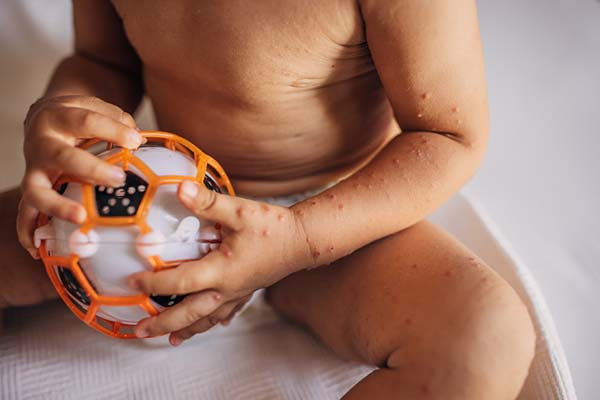Understanding hand, foot and mouth disease: Causes, symptoms, treatment, and prevention
- Reviewed by Howard E. LeWine, MD, Chief Medical Editor, Harvard Health Publishing; Editorial Advisory Board Member, Harvard Health Publishing

Hand, foot, and mouth disease can affect adults and children of any age, but it's more common in young children. It spreads easily, but symptoms of hand, foot, and mouth disease are usually mild.
What is hand, foot, and mouth disease?
Hand, foot, and mouth disease, or HFMD, is a common childhood illness that can also happen in adults. The hallmark symptoms of hand, foot, and mouth disease are sores in the mouth and a rash on the hands and feet.
Outbreaks of HFMD occur most often during the summer and fall. Hand, foot, and mouth disease usually is not serious and goes away on its own in about a week to 10 days.
Hand, foot, and mouth disease is caused by an enterovirus, most often a coxsackievirus. An enterovirus is a type of virus that typically lives in a person's digestive tract, which includes the mouth, throat, intestines, and rectum.
HFMD is sometimes confused with hoof and mouth disease, but this disease only happens in animals with hooves, like cows, sheep, and pigs. People can't get hoof and mouth disease.
Hand, foot, and mouth disease symptoms
Symptoms of hand, foot, and mouth disease include:
- a rash on the hands, bottom of the feet, or both, that may be itchy. The rash may look like small flat spots and can turn into blisters. Sometimes the rash spreads to the knees, elbows, buttocks, and genitals.
- sores inside the mouth that can be painful
- sore throat
- headache and fever
- swollen lymph nodes in the neck
- feeling tired
- not wanting to eat much.
Infants with hand, foot, and mouth disease may have small red spots on their tongue and inside their mouth. Signs that swallowing may be painful for babies with hand, foot, and mouth disease include not eating or drinking, and drooling more than usual.
Some adults who get hand, foot, and mouth disease may not have symptoms, but they can still pass it to others.
How and when HFMD spreads
Hand, foot, and mouth disease is very contagious and spreads easily. You can get it:
- through close contact with a child or adult infected with the virus
- when someone with HFMD sneezes or coughs and you breathe in the droplets
- if you touch something, such as a doorknob or toy, that is contaminated with the virus and then touch your eyes, nose, or mouth
- by coming into contact with the bowel movements or open blisters of someone who is infected.
People who have HFMD are usually most contagious during the first week that they have the virus. Most are no longer contagious after seven to 10 days.
After HFMD goes away, the child or adult who had it develops an immunity to the virus that caused it. However, because several different viruses can cause hand, foot, and mouth disease, you can get it again from a different enterovirus.
Large outbreaks of hand, foot, and mouth disease are uncommon in the U.S.
Diagnosing hand, foot, and mouth disease
Most doctors can diagnose HFMD by looking at the rash and mouth sores. In some cases, the doctor may swab a child's throat and send the swab to a lab. The doctor also may ask the parent to collect a stool sample from the child so it can be tested for the virus.
Treatment options for hand, foot, and mouth disease
Because hand, foot, and mouth disease is caused by a virus, antibiotics don't work. Treatment focuses on relieving symptoms.
Some at-home tips to ease discomfort include:
- Take over-the-counter pain relievers to treat fever and sore throat, such as acetaminophen or ibuprofen. Avoid giving products that contain aspirin to children because of the risk of Reye syndrome, a rare but serious illness.
- Gargling with salt water can help sore throat pain. Try combining 1/2 teaspoon of salt with one glass of warm water, stir, and gargle.
- Drink plenty of cold fluids. Hot beverages, juices, and soda can make mouth sores painful. For children, cold milk products or cold Pedialyte are best.
- Avoid food that is spicy or acidic.
- Older children and adults can use a numbing mouthwash or spray to ease pain.
If you or your child has severe pain or other symptoms, a doctor may be able to provide other treatments to help relieve symptoms.
Pregnant women should call their doctor if they are exposed to hand, foot, and mouth disease or think they may have it.
Prevention strategies
There is no vaccine to prevent hand, foot, and mouth disease, but you can take steps to help prevent it. They include:
- Wash your hands often with soap and water. This is especially important after using the toilet, changing diapers, before eating, and before preparing food.
- Clean and disinfect surfaces and items that are frequently touched, such as toys and doorknobs.
- Keep your hands away from your eyes, nose, and mouth.
- Avoid close contact with anyone who has hand, foot, and mouth disease. This includes avoiding hugging, kissing, and sharing food.
- Cover your mouth and nose with a tissue or your sleeve (not your hands) when coughing or sneezing, and encourage children to do the same.
About the Author

Lisa Catanese, ELS, Health Writer
About the Reviewer

Howard E. LeWine, MD, Chief Medical Editor, Harvard Health Publishing; Editorial Advisory Board Member, Harvard Health Publishing
Disclaimer:
As a service to our readers, Harvard Health Publishing provides access to our library of archived content. Please note the date of last review or update on all articles.
No content on this site, regardless of date, should ever be used as a substitute for direct medical advice from your doctor or other qualified clinician.















